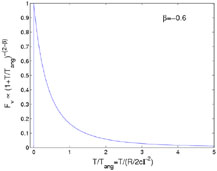


B. Relativistic time effects
Consider first a source moving relativistically with a constant
velocity along a line towards the observer and two photons
emitted at R1 and R2. The first
photon (emitted at R1) will reach the observer at time
(R2 - R1) / v -
(R2 - R1) / c before
the second photon (emitted at R2). For
 >> 1 this equals
>> 1 this equals
 (R2
- R1) / 2c
(R2
- R1) / 2c
 2. This
allows us to associate an "observer time" R / 2c
2. This
allows us to associate an "observer time" R / 2c
 2 with
the distance R and for this reason I have associated a scale
c
2 with
the distance R and for this reason I have associated a scale
c  t
t
 -2 with
fluctuations on a time scale
-2 with
fluctuations on a time scale
 t in the optical
depth
equation earlier (see Section IVA). This
last relation should be modified if the source moves a varying velocity
(v=v(R)). Now
t in the optical
depth
equation earlier (see Section IVA). This
last relation should be modified if the source moves a varying velocity
(v=v(R)). Now
 |
(7) |
which reduces to
 |
(8) |
for motion with a constant velocity. The difference between a constant velocity source and a decelerating source introduces a numerical factor of order eight which is important during the afterglow phase [363].
Consider now a relativistically expanding spherical shell, or at
least a shell that is locally spherical (on a scale larger than
1 /  ). Emission from
parts of the shell moving at angle
). Emission from
parts of the shell moving at angle
 relative to the line of sight to the observer will arrive later
with a time delay
R(1 - cos
relative to the line of sight to the observer will arrive later
with a time delay
R(1 - cos ) /
c. For small angles this time delay equals
R
) /
c. For small angles this time delay equals
R 2 /
2c. As the radiation is beamed with an effective beaming angle
2 /
2c. As the radiation is beamed with an effective beaming angle
 1 /
1 /
 most of the
radiation will arrive within a typical angular time scale:
most of the
radiation will arrive within a typical angular time scale:
 |
(9) |
The combination of time delay and blueshift implies that if the
emitted spectrum is a power law spectrum with a spectral index
 then the observed
signal from the instantaneous emission
of a thin shell will decay at late time as a power law with
t-(2-
then the observed
signal from the instantaneous emission
of a thin shell will decay at late time as a power law with
t-(2- )
[94,
272].
The observed pulse from an instantaneous flash from a thin shell is
shown in Fig. 14.
)
[94,
272].
The observed pulse from an instantaneous flash from a thin shell is
shown in Fig. 14.
 |
Figure 14. The observed
pulse from an instantaneous flash from a spherical relativistic
thin shell moving relativistically and emitting emitting with a
power low |
As I discuss later (see Section VIA) the similarity between the angular time scale and the radial time scale plays a crucial role in GRB models.